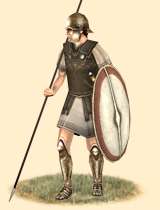Misthophoroi Thureophoroi (Mercenary Hellenic Spearmen)
 |
Weapons | Defence | Mental | ||||||
|---|---|---|---|---|---|---|---|---|---|
| Primary | Secondary | Armour: | 10 | Morale: | 11 | ||||
| Type: | spear | spear | Shield: | 3 | Discipline: | normal | |||
| Attack: | 6 | 14 | Skill: | 8 | Training: | trained | |||
| Charge: | 4 | 4 | Recruitment | Other | |||||
| Lethality: | 1 | 0.13 | Soldiers: | 40 | Hit Points: | 1 | |||
| Range: | 35 | 0 | Cost: | 1337 | Mass: | 1.15 | |||
| Ammo: | 3 | 0 | Upkeep: | 334 | |||||
| Turns: | 1 | ||||||||

Thureophoroi were a new class of Hellenic infantry. They are an extremely mobile force that can hit hard with their heavy javelins then rush in to flank pike units.
Sapping Ability
Thureophoroi were a new class of Hellenic infantry that was designed to both augment the phalanx and provide a type of soldier in between the Phalangite and the Peltast that was able to skirmish and fight in melee. They are an extremely mobile force that can hit hard with their heavy javelins then rush in to flank pike units. They are well armed and armored for the task, having stout bronze helms, linen armor, an almond shaped theuros shield, heavy javelins, and a stout spear. They are highly versatile infantry, akin in spirit to the legionnaires of Rome. They are usually Pezhetairoi, middle class property owners with voting rights. As such, they are well able to devote time to training and practice. They have good morale and are highly disciplined. They were often described by Latin writers as copies of the legion. It is debatable whether they were developed with knowledge of warfare in Italy or not, they are a highly effective force of heavy infantry that is in the forefront of Hellenic military know-how.
Historically, Theurophoroi were used as harassing and flanking troops by the successor states. There seemed to be a lot of confusion as to how to utilize these new soldiers, since they were deadly in the extreme to the less mobile phalanx units. Most of the successor states used them conservatively, except for the Seleukeis, who took to these new soldiers quite well. The city-states of Greece used them even more frequently against the armies of Makedonia, and were often able to hold the more powerful kingdom at bay. Still, their uses were limited in scope and not as widespread as their versatile and deadly role would have indicated. This is the fault of their commanders, however, and any more astute or innovative commander might have realized their potential in conjunction with the more static Phalanx.